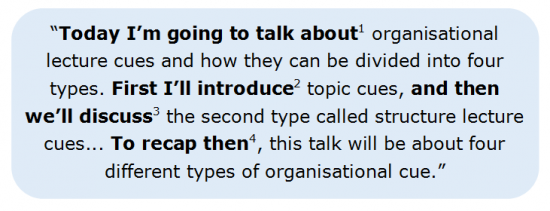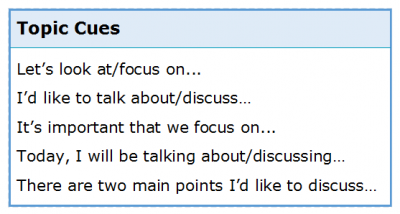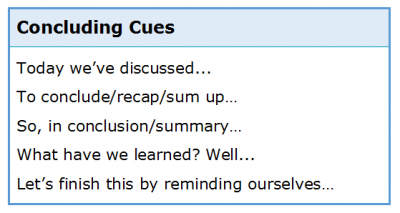What are organisational listening and lecture cues?

This is the second of four chapters about Listening for Lecture Cues. To complete this reader, read each chapter carefully and then unlock and complete our materials to check your understanding.
– Introduce the concept of organisational lecture cues
– Divide organisational lecture cues into four types
– Provide examples of each type to assist comprehension
Before you begin reading...
-
video and audio texts
-
knowledge checks and quizzes
-
skills practices, tasks and assignments
Chapter 2
When considering a lecture from the perspective of the speaker, we can assume that their primary aim is to deliver the content of that lecture in whichever way will most easily and logically facilitate listening and understanding. Therefore, much like how an introduction functions in an essay, a good lecturer will consider how to clearly signal the overall structure of a presentation as well as indicate to the listener any main or supporting ideas. Consider the following introduction:

Here we see written in bold three different types of organisational listening and lecture cue. The first cue (1) in this example is a topic cue. Topic cues such as this are used to introduce the main and supporting ideas of a lecture or presentation:

The second type of organisational cue (2/3) is used to provide order to the lecture, perhaps to indicate which main or supporting ideas will be dealt with first. Such cues are labelled structure cues, and involve examples such as the following:

The third and final type of organisational cue shown in the example introduction is called the concluding cue (4). In addition to properly signposting the main ideas and order of a lecture, the presenter will also likely wish to indicate when they are concluding an idea or summarising the most important information. Much like in the main body section of an essay, it can be effective for a presenter to conclude as they go along to increase the coherency of their presentation.

While the examples so far will provide a student with the language needed to follow the overall organisation of a lecture, perhaps one of the most valuable skills when listening is being able to recognise when a speaker is transitioning from one idea to the next. Unlike in essays, lectures do not have visible paragraph breaks to indicate a change in topic or main idea. Therefore, it’s necessary to know when transitional cues such as the examples provided below are being used.

You’ve probably noticed in the above examples that such transitional cues can simply be words like ‘now’ (which are usually punctuated with a pause), phrases such as ‘let’s move on to’, or rhetorical questions such as ‘what does this mean’. With rhetorical questions such as these, the presenter does not really require an answer and is simply using this cue to move from one idea to the next.
Now that you understand and can hopefully recognise organisational lecture cues, the next type to pay attention to in Chapter 3 is the informative lecture cue.
Downloadables
Once you’ve completed all four chapters about listening for lecture cues, you might also wish to download our beginner, intermediate and advanced worksheets to test your progress or print for your students. These professional PDF worksheets can be easily accessed for only a few Academic Marks.
Collect Academic Marks
-
100 Marks for joining
-
25 Marks for daily e-learning
-
100-200 for feedback/testimonials
-
100-500 for referring your colleages/friends